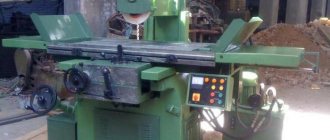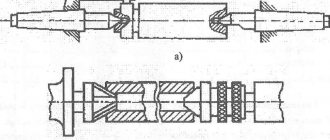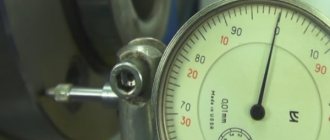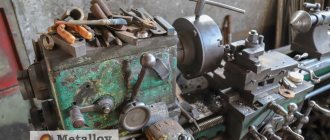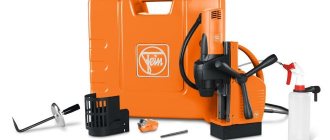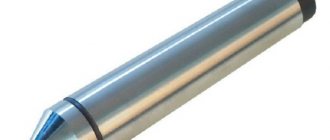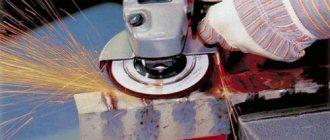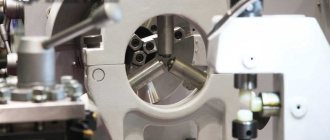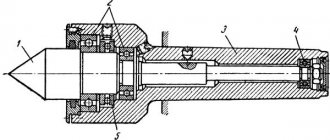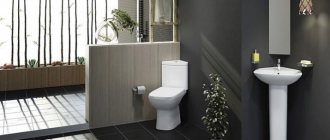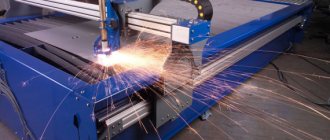What is it for?
A lathe processes parts of different lengths, including long workpieces of small diameter. They are fixed at 2 points (ends), and as they move away from the place of fixation, the likelihood of longitudinal deformation increases when exposed to a cutting tool.
Under such conditions, it is very difficult, and sometimes simply impossible, to ensure the required processing accuracy and perfect cylindricity.
In addition, a vibrating workpiece damages the working tool and equipment. When working at high speeds, there is a risk of destruction of the part in the central part, which can lead to injury to the worker.
The steady rest is an additional support that increases the stability of the workpiece being processed. In this way, it is possible to eliminate the deformation and vibration of the part.
Work safety is significantly improved. The device is usually used in cases where the length of the workpiece exceeds its diameter by 10 or more times.
Installation of steady rests for lathes
Several methods can be used to install steady rests .
This device can be placed on the workpiece if the following condition is met: the part has exact geometric dimensions or has already been processed. It is permissible to resort to this method only if rough work is planned. In situations where there is deflection of the workpiece caused by its own weight, you must first bring two cams to it, and only then fix the upper one.
If you have to perform finishing and precise work , then using a similar method of installing a steady rest is unacceptable. The fact is that if miscalculations are made with the placement of this device, there is a high probability that the workpiece will have different diameters along its entire length.
If the workpiece has a machined surface for installing the steady rest, it is recommended to use a short mandrel, which is usually a cylindrical roller, with a diameter equal to the diameter of the workpiece in the area where it will contact the steady rest. One end of the mandrel must be fixed in the chuck, while the other, which must first be aligned using a thicknesser or indicator , or can be ground, is used to install the steady rest cams.
This device itself should at this moment be located next to the headstock, and when the cams are in their workplace, it is moved parallel to the bed until it takes the required position.
Design and principle of operation
The task of the steady rest is to ensure strict horizontality of the workpiece without interfering with its rotation around its own axis. The principle of its operation is based on centering the part using several supports located evenly in a circle.
Freedom of rotation is maintained due to the fact that the support has a rotating roller (bearing) at the point of contact with the workpiece.
Centering is ensured by the possibility of its movement in the longitudinal direction using a cam or spring mechanism.
The design of the device is quite complex. It is based on an all-metal base, which is bolted to the machine bed. It contains supports with an individual extension mechanism.
Adjustment of movement and fixation of supports is provided by adjusting screws. Some types of steady rests have metal covers that can be moved.
Overview of types of steady rests for lathes
A steady rest is an additional device for a machine that acts as a main or secondary support when working with workpieces. The device is often used to provide stability to workpieces and avoid damage or deformation. There are several types of steady rest for a lathe, each of which has its own effect on the processing of workpieces. In this article we will analyze all the functionality of this device, its advantages and disadvantages.
Kinds
Steady rests are designed for various types of lathes and processing of parts of various shapes and sizes. For more efficient use, they are manufactured in 2 main versions - fixed and movable type.
Fixed
A steady or static type rest is installed on a frame and consists of a base and a hinged cover hinged to the base. The supports are made in the form of cams, with 2 of them located on the base, and the top one on the cover.
In essence, during processing, the workpiece rests on the lower supports and is pressed from above. To install a fixed steady rest, a lower bolted engagement is provided.
Mobile
A movable or mobile type steady rest is placed on a machine support carriage. This makes it possible to move it, coinciding with the movement of the working tool (cutter).
A special feature of this device is the mandatory presence of 2 supports, since the role of the 3rd support is played by the cutter itself. Supports (cams or rollers) are located on the top and side (opposite the cutter).
The mobile steady rest allows you to increase the accuracy of work, since it is located directly in the processing area. Depending on the model, it is possible to use workpieces with a diameter from 20 to 260 mm.
Structure of a static steady rest
The main task of a static steady rest is to support large parts while working with them. The stationary device is installed on the frame using the lower gearing. This device helps improve the accuracy of the workpiece and avoid unnecessary vibration. A static device has several key elements:
- base;
- hinged lid.
The design of the device for working fixation is equipped with a hinged bolt with a special head.
There are three cams on the lid of the steady and at the base, designed for fixation. By adjusting them, the operator has the opportunity to adjust the device to the size of the part being processed. Lunette clamps are most often made of cast iron. This helps avoid damage to fragile parts. A special coating is installed on the cams , which serves as protection. Most often, such a protective coating is created by the manufacturers of steady rests themselves.
However, not only the workpieces can suffer from the clamps, but also the cams themselves wear out during operation. Therefore, they are also produced on the basis of hard alloys.
Static steady rests are installed in several stages:
- The workpiece is fixed in the center of the machine.
- Pre-set three cams of the device.
- Grind the neck of the workpiece at the point of its contact with the cams.
- Fix the workpiece.
It should be noted that preliminary turning of the workpiece neck is not always required. Turning may not be performed if the part is pre-processed and has fixed dimensions.
By what principle to choose
When choosing a device model, you should pay attention to a number of factors. First of all, technical characteristics are considered - the internal diameter of the base of the steady rest, its dimensions and weight, the maximum (minimum and maximum) diameters of the workpiece, the recommended length of the workpiece, the method of fastening.
It is important to have a protective cover and a special coating for wear elements. The type of machine and the types of turning work determine the type of device required (movable or fixed).
Advantages and disadvantages
The main advantages of using steady rests:
- expanding the capabilities of the lathe;
- increasing processing accuracy;
- reduction in the number of defects;
- ease of use (installation and configuration);
- increased safety for operating personnel.
It is important to note that the movable steady rest is easier to install, but the fixed version provides increased processing accuracy and makes it possible to work with longer and larger parts.
Important!
The lunette does not reveal any serious technical shortcomings. Defects arise from incorrect placement and inaccurate adjustment of supports, and therefore careful monitoring of the installation of the device and fixation of the workpiece itself is required.
Performance and Cost
As the main disadvantages, many experts note the impact on the productivity of turning operations and the need for additional costs.
The decrease in productivity is associated with the time spent installing steady rests and adjusting supports. This requires careful adjustment and repeated testing. In some cases, preliminary processing of the workpiece is carried out at the place of fixation.
Another important point is the financial costs caused by the fairly high cost of devices. It depends on the type of steady rest, its model, manufacturer, technical capabilities, materials used, the presence of protective coatings and other factors.
The cost of movable models is slightly lower than fixed steady rests of the same category. Thus, the price of mobile devices ranges from 1100-1300 rubles for simple products to 4500–4800 rubles for steady rests of increased durability.
Fixed varieties are sold at prices from 1800 to 6500 rubles, respectively.
Important nuances
Please be aware of the following important points before purchasing or using these devices:
- Turning the place where the part comes into contact with the steady rest clamps can only be carried out in the case of rough work. If the part has fixed dimensions or its surface has already been pre-treated, then there is no need to pre-turn it.
- If the operator is carrying out finishing work, but there is a need to securely fasten the part, then a special cylindrical pad roller can be used. In diameter, it should be similar to the diameter of the workpiece being processed at the point of its contact with the cams of the steady rest. One part of the lining is fixed in the device, and the other in the machine chuck.
- When working with very thin or long parts, it is not always possible to pre-grind the neck for installation in the rest. In this case, it is recommended to make several temporary necks with maximum proximity to the headstock.
- It is advisable to adjust the machine cutter with a negative angle. Otherwise, it may push the part away from itself, as a result of which the processing accuracy will decrease.
The main manufacturers of steady rests are Jet (USA), Dnepropress (Ukraine), Astrakhan Machine Tool Plant (Russia), Zmm (Bulgaria), Proxxon (Germany), SMTCL (China).
Republished by Blog Post Promoter
How to make it yourself
Homemade designs allow you to reduce the cost of lathe equipment. You can offer an option based on a flange for a pipe connection (diameter: external - 20 cm, internal - 11 cm).
3 studs 15 cm long and with M14 thread are used as cams. A handle is formed on top of them, and a bronze cap with a hole with a diameter of 14 mm is fixed at the bottom.
The flange is marked into 3 sectors (120 degrees each). According to the markings, holes are drilled towards the center of the circle. For adjustment, M14 nuts are welded into which studs are screwed.
The base for attaching to the machine is made from a 100 mm angle (steel thickness is at least 10 mm). It is welded to the flange.
Holes are made in the base to secure the fixture to a standard machine head mounting plate.
Design options for homemade lunettes
A steady rest for a lathe is not cheap, so there is little point in buying one if the device is not used very often. It’s easier then to make a steady rest with your own hands. For example, for the IZh1 lathe, you can implement a homemade product using the following design:
- A flange for connecting pipes is used as the base where the cams will be fixed. The flange size is 200 mm in outer diameter and 110 mm in inner diameter. Using a protractor, the flange is divided with a marker into three equal sectors with an angle of 120 degrees each. The sector connection lines will be exactly the places where you need to secure the cam feed mechanisms.
- Instead of cams, you can use three studs with 14 threads and a length of 150 mm each. Handles are welded onto the studs from one end (pieces of wire 8 mm in diameter and 30 mm long, so that it looks like the letter “T” in shape); on the other end, three bronze pointed caps with an internal thread diameter of 14 are ordered from a turner.
- The mechanism for adjusting and fixing the cams can be made from three nuts with an internal thread of 14 (for each cam), two of which are welded opposite each other along lines pre-drawn on the flange.
The homemade steady rest is ready for use. Pre-tightened nuts with engravers serve as clamps when setting the cams to the required position.
Everyone who is in the subject, support the discussion in the comments! Perhaps you have other interesting designs for making lathe steady rests with your own hands!
Advantages and disadvantages
When using steady rests, the following positive qualities are noted:
- machine operator safety;
- accuracy of product dimensions;
- vibration reduction;
- prevention of workpiece and tool destruction;
- expansion of the range of sizes of processed parts;
- simple design;
- reliability.
Among the shortcomings, the short service life of the elements directly in contact is noted. To reduce loads, the supports are made of cast iron or bronze. Roller bearings are more durable, but support bearings are quickly destroyed, especially if their feed is mechanized.
Pros and cons of steady rests
When working on a lathe, you need to know that the use of a steady rest in some cases is simply necessary. This primarily applies to very long workpieces that sag under their own weight. Therefore, when using a device, it is important to make the most of its advantages and, if possible, avoid negative effects that may appear during the work if done incorrectly.
A steady rest for a lathe, installed according to all the rules, greatly facilitates the operator’s work:
- Processing is easier, since the load on the cutter becomes the same at all points of contact;
- The risk of defects is reduced due to more accurate alignment of the part;
- Processing accuracy increases;
- Increases operational safety by eliminating part runout, the risk of damage and jamming of the cutter;
- Processing speed increases;
- The possibilities of using a lathe are expanded;
- The device is easy to install and requires only precise alignment of the adjusting bolts.
There are certain difficulties in working with a steady rest, which can be avoided with the proper approach to installing the device:
- A poorly aligned mechanism leads to product defects, since the center of rotation of the workpiece shifts relative to the cutter;
- The lunette can only be installed on a pre-treated surface, or a groove can be made for it;
- Devices for a machine with retractable jaws are best used for rough turning of parts;
- For finishing turning, you must have in your arsenal a device with retractable rollers that does not leave marks on the workpiece;
- The installation and adjustment time of equipment reduces the intensity of the production process;
- Purchasing a steady rest is an additional financial cost.
How to install and adjust the support fixture
Typically, a steady rest for a lathe is secured to the required point with a bolt before the workpiece is centered. After that:
- All cam or roller stops are screwed completely into the base of the device;
- Next, the movable part of the device is folded back using a hinge;
- The part itself is fixed on the lathe and its diameter is measured at the point of future contact with the steady rest;
- Close the lid and fix it to the base with a special bolt;
- Pull out the cams so that the diameter between them strictly corresponds to the diameter of the workpiece;
- When correctly aligned, the steel jaws should rest against the part and when turning it by hand, it should rotate evenly.
There are several ways to position the device - using a specific workpiece, a special stand with a built-in micrometer. In the first case, the blank must be fixed in the centers and have a geometrically precise circle at the point of contact with the rest. That is, it is pre-sharpened. If the device needs to be positioned under a machined workpiece beforehand without the presence of the latter, high-precision measuring instruments are used.
Another method of adjusting the stops is often used in production shops, when the steady rest is not aligned with the actual workpiece, but with a round steel bar, on which the required diameter is machined at the location where the support device is installed. For greater reliability, after installing the blank, it is necessary to check the quality of rotation. It should be free and not cause additional loads or vibrations.
Related video: Do-it-yourself steady rest on a lathe
Rolling process, types and purpose
Shaping during the rolling procedure is performed without producing chips. It consists in the fact that a tool (roller, cutter, etc.) is pressed into the body of the material and, due to surface deformation, a corresponding profile is obtained. As we can see, knurling is a cold method of processing the surface layer of a part in a process in which a mesh, threads, marks, notches and other roughness are formed without violating GOST.
This allows the surface of a number of parts (handles, handles, screw heads) of machines and devices to have roughness in the form of a certain corrugated pattern for ease of use. At the moment, two main types of turning knurling are practiced:
- formative;
- strengthening;
The first option is used in shaping teeth on wheels and shafts, threads on products, and applying scales on devices. Hardening rolling of the surface of the material is used to increase strength and wear resistance. During lathe rolling, a hardening is formed on the surface of the workpiece, which helps to improve the performance properties of the material, and GOST is maintained. In this way, plastic deformation of shafts, bushings, axles and other products is performed.
The turning knurling procedure is carried out quickly, and taking into account the additional properties obtained, the production of such parts in mass production becomes economically profitable. The turning knurling method is used for crafts due to increased requirements for the performance characteristics of equipment: strength, high productivity, speed, accuracy and other qualities. This method is used only on crafts with a pre-prepared surface.
Types of knurling rollers for corrugation
Hardening of the surface layer is required to improve the performance characteristics of parts, as required by GOST. After turning, they are less sensitive to damage from fatigue, wear resistance and anti-corrosion abilities increase, microcracks and risks are removed. The workpiece acquires the desired size and shape. Lathes are most often used to perform this type of work.
How to install and adjust the support fixture
The steady rest is installed only in the place where the workpiece has a strictly cylindrical shape or has been pre-treated in the presence of deformations.
The base of the device is bolted to the machine. The first step is to adjust the lower supports. The part must lie horizontally on them, which is checked with a measuring device along its entire length.
If there is sagging in a workpiece of small diameter, it is raised to the required height using the moving mechanisms of the lower supports.
Next, using the upper support, the part is fixed and centered. After the adjustments are completed, torque is created without supplying the cutter. The presence of beats (vibrations) is checked. Only after a thorough check can you begin to work.
When processing long workpieces on a lathe, it is simply necessary to use a steady rest. It can have a different design depending on the type of machine and the type of part.
When choosing a device, you need to pay special attention to its technical characteristics and the strength of the materials used.
